Physical Vapor Deposition: 6 Essential Questions
What is PVD?
PVD or physical vapor deposition is a vaporization technique that involves a transfer of material on an atomic level. Similar to chemical vapor deposition or CVD, the process is considered an alternative to electroplating. PVD is process that goes through the following 4 stages: evaporation, transportation, reaction, and deposition.
What are PVD materials?
PVD materials refer to a slew of metals that can be used to create thin films and coatings on various surfaces. There are a number of advantages to choosing this deposition technique over others.
Pros of PVD Coatings:
- Durability. PVD coatings are hardier and have a greater resistance to corrosion than other coatings. Therefore, if you want a coating that will last, it is a great choice to consider.
- Heat-Resistant. While a number of coatings can also resist high temperatures, PVD coatings are sturdy enough to ensure that high temperatures won’t damage the surface of the material and compromise it.
- Versatile. You don’t have to limit your choice to only few inorganic materials. The PVD coating process works on almost any kind of inorganic and organic material.
- Eco-Friendly. PVD is a much better choice than electroplating or painting since it’s more environmentally-friendly.
Cons of PVD Coatings:
- Technique. Line of sight (LOS) techniques make it more difficult for to coat the undercuts of the material as well as other similar features of the surface.
- Cost. This technology doesn’t come cheap. You’ll have to invest a good chunk of capital before you have the materials in place. However, the results are worth every penny once you see the quality of the finished materials.
- Requires Skilled Operators. PVD typically mean processes that require tremendously high temperature settings. This means operators must be skilled and trained to be fully on their guard. A single misstep could land them in a whole lot of trouble.
Common Applications for PVD Coatings
Since PVD coatings are known to enhance the oxidation resistance of a surface, it’s often used in a number of different applications. Some common applications include: automotive, cutting tools, fire arms, dies and molds for processing materials, and aerospace.
Where to shop for PVD materials and coatings?
Look for reliable PVD manufacturers that provide quality PVD coatings, like ACI Alloys. With over 30 years of industry experience, you’re always in good hands.
